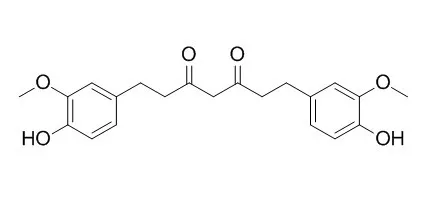| In vivo: |
| Chem Biol Interact. 2015 Jun 25;235:95-105. | | Ameliorative efficacy of tetrahydrocurcumin against arsenic induced oxidative damage, dyslipidemia and hepatic mitochondrial toxicity in rats.[Pubmed: 25869292] | Arsenic (As) is a well-known human carcinogen and a potent hepatotoxin. Environmental exposure to arsenic imposes a serious health hazard to humans and other animals worldwide. Tetrahydrocurcumin (THC), one of the major metabolites of curcumin, exhibits many of the same physiological and pharmacological activities as curcumin and in some systems may exert greater antioxidant activity than the curcumin. It has been reported that THC has antioxidant efficacy attributable to the presence of identical β-diketone of 3rd and 5th substitution in heptane moiety.
METHODS AND RESULTS:
In the present study, rats were orally treated with arsenic alone (5 mg kg(-1) bw/day) with THC (80 mg kg(-1) bw/day) for 28 days. Hepatotoxicity was measured by the increased activities of serum hepatospecific enzymes, namely aspartate transaminase, alanine transaminase, alkaline phosphatase and bilirubin along with increased elevation of lipid peroxidative markers, thiobarbituric acid reactive substances. And also elevated levels of serum cholesterol, triglycerides, free fatty acids and phospholipids were observed in arsenic intoxicated rats. These effects of arsenic were coupled with enhanced mitochondrial swelling, inhibition of cytochrome c oxidase, Ca(2+)ATPase and a decrease in mitochondrial calcium content. The toxic effect of arsenic was also indicated by significantly decreased activities of enzymatic antioxidants such as superoxide dismutase, catalase, and glutathione peroxidase along with non-enzymatic antioxidant such as reduced glutathione. Administration of THC exhibited significant reversal of arsenic induced toxicity in hepatic tissue. All these changes were supported by the reduction of arsenic concentration and histopathological observations of the liver.
CONCLUSIONS:
These results suggest that THC has a protective effect over arsenic induced toxicity in rat. | | Chem Biol Interact. 2015 Jun 20;238:118-128. | | Tetrahydrocurcumin exerts protective effect on vincristine induced neuropathy: Behavioral, biochemical, neurophysiological and histological evidence.[Pubmed: 26102012] | Hyperalgesia, allodynia, delayed motor nerve conduction velocity, oxidative stress and axonal damage are signs and symptoms of chemotherapy induced peripheral neuropathy (CIPN). Present treatment/preventive strategies of CIPN are futile and the neuropathy may even lead to discontinuation of chemotherapy.
METHODS AND RESULTS:
In this study, we evaluated the protective effect of Tetrahydrocurcumin (THC) 40 and 80mg/kg in experimental vincristine induced neuropathy in rats. Hyperalgesia was assessed by hot plate (thermal), Randall-Selitto (mechanical) test, allodynia was assessed by cold plate (thermal) test, functional loss was measured by sciatic function index, nociception was evaluated by formalin test. Neurophysiological recordings were carried out to assess motor nerve conduction velocity. Total calcium levels, oxidative stress and TNF-α was measured in sciatic nerve tissue homogenate to assess neuropathy. Histopathological changes was observed on sciatic nerve to assess the protective effect of THC against the vincristine. Pregabalin was used as a standard in this study. Rats administered with THC at 80mg/kg significantly attenuated the vincristine induced neuropathic pain manifestations which may be due to its multiple actions including anti-nociceptive, anti-inflammatory, neuroprotective, calcium inhibitory and antioxidant effect.
CONCLUSIONS:
This study delineates that THC can be a promising candidate for the prevention of CIPN by chemotherapeutic agents. | | Biomed Res Int. 2015;2015:391748. | | Effects of tetrahydrocurcumin on hypoxia-inducible factor-1α and vascular endothelial growth factor expression in cervical cancer cell-induced angiogenesis in nude mice.[Pubmed: 25789317] | Tetrahydrocurcumin (THC), one of the important in vivo metabolites of curcumin, inhibits tumor angiogenesis. Its effects on angiogenesis in cervical cancer- (CaSki-) implanted nude mice and its mechanisms on hypoxia-inducible factor-1α and vascular endothelial growth factor expression were investigated.
METHODS AND RESULTS:
Female BALB/c nude mice were divided into control (CON) and CaSki-implanted groups (CaSki group). One month after the injection with cervical cancer cells, mice were orally administered vehicle or 100, 300, and 500 mg/kg of THC daily for 30 consecutive days. The microvascular density (MVD) was evaluated using the CD31 expression. VEGF, VEGFR-2, and HIF-1α expression were also detected by immunohistochemistry. The MVD in CaSki + vehicle group was significantly increased compared to the CON + vehicle group. Interestingly, when treated with THC at all doses, the CaSki group showed a significant smaller number of the MVD. The CaSki + vehicle group also showed significantly increased VEGF, VEGFR-2, and HIF-1α expressions, but they were downregulated when mice were treated with THC at all doses. THC demonstrated an inhibitory effect against tumor angiogenesis in CaSki-implanted nude mice model. This effect is likely to be mediated by the downregulation of HIF-1-α, VEGF expression, and its receptor.
CONCLUSIONS:
THC could be developed into a promising agent for cancer therapy in the future. |
|






 Cell. 2018 Jan 11;172(1-2):249-261.e12. doi: 10.1016/j.cell.2017.12.019.IF=36.216(2019)
Cell. 2018 Jan 11;172(1-2):249-261.e12. doi: 10.1016/j.cell.2017.12.019.IF=36.216(2019) Cell Metab. 2020 Mar 3;31(3):534-548.e5. doi: 10.1016/j.cmet.2020.01.002.IF=22.415(2019)
Cell Metab. 2020 Mar 3;31(3):534-548.e5. doi: 10.1016/j.cmet.2020.01.002.IF=22.415(2019) Mol Cell. 2017 Nov 16;68(4):673-685.e6. doi: 10.1016/j.molcel.2017.10.022.IF=14.548(2019)
Mol Cell. 2017 Nov 16;68(4):673-685.e6. doi: 10.1016/j.molcel.2017.10.022.IF=14.548(2019)